Vertical
ABOUT DRAGOŠ KALAJIĆ’S (1943-2005) ”KNIGHT OF THE ORDER OF LIGHT” EXHIBITION, IN EIGHT THUNDERING VOICES
Outlines of Our Internal Empire
His art and ideas indicated an order older than the Fall and history. Serbian culture needs a new reading of Dragoš Kalajić, purified from everything marginal and accidental, and his permanent positioning in a place that indisputably belongs to him. In Western Europe and Russia, much more often and more consistent than in Serbia, Kalajić is mentioned together with Evola and Malaparte, with Jünger and Dumézil, with Solzhenitsyn and Zinoviev, with De Chirico and Glazunov. They are not forgetting how many generations and layers of culture it takes for the appearance of a personality with such knowledge and importance in a nation
By: Matija Vojinović
Illustrations: Archive of ”National Review”
2001 copy.jpg) An endless blue circle and in it a Man watching a star. The golden outlines of ”our internal empire”, under the white boiling of clouds, above the world and time. Crystals of spirit and memory scattered like galaxies, like cosmograms. The ”heroic realism of action” and visionary courage on the road of return of the Man to his heavenly homeland and his own original rank. On the path ”from prehistory to above-history”, in a struggle when decisions are made ”whether a human will be smaller than an ant or something more than a human”. Hyperborean runes, the graphic expression of the human’s position in God’s creation, and the codes of legends about the ”road of ancestors” and ”road of gods”. A mysterious woman with flaming hair, an imperial eagle and a tiger who submits to words. A geometry of edifices and continents we carry within, of edifices which built us. Belvederes towards eternity. ”Let us look into our eyes: we are Hyperboreans! There, behind the north, ice and death, there is our life, there is our home.” ”Go out and fight! It’s the only thing you can do for your immortality.”
An endless blue circle and in it a Man watching a star. The golden outlines of ”our internal empire”, under the white boiling of clouds, above the world and time. Crystals of spirit and memory scattered like galaxies, like cosmograms. The ”heroic realism of action” and visionary courage on the road of return of the Man to his heavenly homeland and his own original rank. On the path ”from prehistory to above-history”, in a struggle when decisions are made ”whether a human will be smaller than an ant or something more than a human”. Hyperborean runes, the graphic expression of the human’s position in God’s creation, and the codes of legends about the ”road of ancestors” and ”road of gods”. A mysterious woman with flaming hair, an imperial eagle and a tiger who submits to words. A geometry of edifices and continents we carry within, of edifices which built us. Belvederes towards eternity. ”Let us look into our eyes: we are Hyperboreans! There, behind the north, ice and death, there is our life, there is our home.” ”Go out and fight! It’s the only thing you can do for your immortality.”
Divineness without pathetics, heroism without conditioning, fulfillment of duties without retreating. The picture is purified, almost immaterial, colors are bright, with surpluses rejected like removed veils. The knight of the Order of Light steps on the last stair on this side, companion of Adam Kadmon, ”the man from above”. The eyes of the entire universe, of all worlds, are looking at him. ”Everything he has done up to now depends on what he will do now.” Before him is the final temptation, the most difficult and the simplest. An answer to the question: ”Who does the Grail serve?”
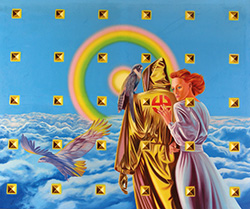 After nine years, we have the pictures of Dragoš Kalajić (1943-2005) in Belgrade again, ”the most Belgradian European and the most European Belgradian”. For the second time after his ”final departure towards the higher stations of a human”. (The first time was in the ”Progres” Gallery, in June 2007.) With the exhibition Knight of the Order of Light, from June 30 to September 16, RTS Gallery gave us, without any doubt, one of the most significant artistic events in several years. From a cultural and political point of view, this is an exemplary act of a principled approach, self-consciousness and courage, a true positive cultural diversion under the invisible lead armor of the sad protectorate called Serbia.
After nine years, we have the pictures of Dragoš Kalajić (1943-2005) in Belgrade again, ”the most Belgradian European and the most European Belgradian”. For the second time after his ”final departure towards the higher stations of a human”. (The first time was in the ”Progres” Gallery, in June 2007.) With the exhibition Knight of the Order of Light, from June 30 to September 16, RTS Gallery gave us, without any doubt, one of the most significant artistic events in several years. From a cultural and political point of view, this is an exemplary act of a principled approach, self-consciousness and courage, a true positive cultural diversion under the invisible lead armor of the sad protectorate called Serbia.
”Dragoš Kalajić was resolute, explicit, authoritarian, but not malicious. He was a good listener, evaluating counter-arguments, and then continuing to dispute them. He was explosive, abundant, cascade, noticeable. Double noticeable. As the one remarkable with his appearance, and as the one who notices well – as our ancestors used this adjective. (...) From afar, I considered him much older, wise, resolute, clear and courageous. He looked like a prophet, a mysterious clairvoyant. (...) Despite the pompous, shiny, blinding aura, I anticipated the sincerity of his convictions. Opposite a possible interpretation of Dragoš’s character and opinions as a pose, I felt that he was consistent and, above all, natural”, said Nikola Mirkov, president of 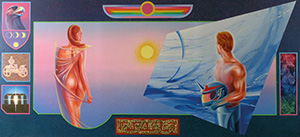 RTS Board for Fine Arts, at the exhibition opening. ”Although readable and clear, the painting of Dragoš Kalajić is hard to pack in a drawer of the big laboratory of Serbian art. The stronghold, a word that Dragoš Kalajić particularly respected, the stronghold of his painting is identical to the stronghold of his life and entire literary, editorial, pedagogical, journalistic, philosophical, media and public activities. Pop-art touched him in his consistent flight, hyperrealism brushed him, he moved through the comic-delic rather than a psychedelic haze, through a transparent, luring magma of the fantastic. He continued his flight towards the ascension of painting, towards the merge of philosophical ideas and icons, towards ‘Hyperborean realism’, as he considered his aspirations. Regardless of the value time will attribute to Kalajić’s painting, it is without a doubt that the starting point of his creative imperative is independent and comprehensive, total. Kalajić’s aspiration to renew painting, to use object and figure to depict philosophical ideas and concepts – light, life energy, flash, flash of thoughts, searching for the essential, for the organic – makes him genuine and unique. For this, Dragoš Kalajić is his own ancestor... and intermediary.”
RTS Board for Fine Arts, at the exhibition opening. ”Although readable and clear, the painting of Dragoš Kalajić is hard to pack in a drawer of the big laboratory of Serbian art. The stronghold, a word that Dragoš Kalajić particularly respected, the stronghold of his painting is identical to the stronghold of his life and entire literary, editorial, pedagogical, journalistic, philosophical, media and public activities. Pop-art touched him in his consistent flight, hyperrealism brushed him, he moved through the comic-delic rather than a psychedelic haze, through a transparent, luring magma of the fantastic. He continued his flight towards the ascension of painting, towards the merge of philosophical ideas and icons, towards ‘Hyperborean realism’, as he considered his aspirations. Regardless of the value time will attribute to Kalajić’s painting, it is without a doubt that the starting point of his creative imperative is independent and comprehensive, total. Kalajić’s aspiration to renew painting, to use object and figure to depict philosophical ideas and concepts – light, life energy, flash, flash of thoughts, searching for the essential, for the organic – makes him genuine and unique. For this, Dragoš Kalajić is his own ancestor... and intermediary.”
A LINK IN THE CHAIN OF TRADITION
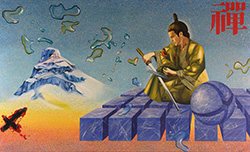 In the reputable national television gallery, one of the two most significant ones in Serbian lands during the past ten years, twelve Kalajić’s big format oils on canvas open up before us like worlds. They were created in the period of almost thirty years and include all important creative phases of this painter, from early anticipation of pop-art (much before Warhol), to mature and late ”hyperborean realism”, uranian and vertical. The oldest exhibited painting is the Diary from 1964, and the youngest Wolfgang from the Portraits of European Nations cycle, 1993.
In the reputable national television gallery, one of the two most significant ones in Serbian lands during the past ten years, twelve Kalajić’s big format oils on canvas open up before us like worlds. They were created in the period of almost thirty years and include all important creative phases of this painter, from early anticipation of pop-art (much before Warhol), to mature and late ”hyperborean realism”, uranian and vertical. The oldest exhibited painting is the Diary from 1964, and the youngest Wolfgang from the Portraits of European Nations cycle, 1993.
”Dragoš used to say that he was only a link in the long chain of Tradition. As a unique phenomenon in the world of art, he paints the contours of Tradition with religious dedication. The blueness of the sky, snowy mountain tops, stone arches of temples, all bathe in transparent colors of the Sun, as if in a heavenly, illuminated castle, where we most often see a man-warrior and a woman, or only one of them, standing and watching into the distance. Who are they and what are they waiting for?” asks Dragan Ćirjanić, famous Serbian director and philosopher of Tradition, at the opening of the Knight of the Order of Light exhibition. ”Dragoš’s paintings are evocations of true Europeans. With old divisions and such a life, no one can get anywhere anymore. (...) Europe is under occupation of dark forces of nihilism. In secularized Europe, deprived of divine principles, only a few artists 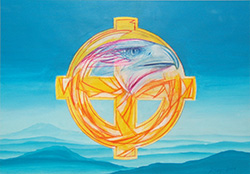 continue to testify the holiness of life. In his painting, Dragoš visualizes an entire Arian cosmogony. His pure and unique style in everything tells a big yes to victorious calmness in the chaos of life. The sacral atmosphere of concentration before a crucial battle evokes the ethos of unity between thoughts and artwork, divine inspiration and readiness for action. (...) Leaning upon the treasuries of the oldest inscriptions of Indo-Europeans, without historicism, he paints a timeless world of an eternal polar Homeland and prepares the return of the lost Empire of Spirit. In those pictures-announcements-revelations, we are in the presence of forces of the Absolute and Authority. Of everything expelled from our world today. Invoking living Tradition, breathing a new life to symbols, Dragoš Kalajić is a herald of the invisible Empire. (...) We are standing before a unique manifestation of a divine principle, before an avatar, incarnation of the eternal law... Just like a seed is a summary of a species, a nucleus of a world. Everything necessary for a new beginning. As in church or myths, they are revealed to those who understand the codes and remain closed for those with an expression of ridicule on the faces.”
continue to testify the holiness of life. In his painting, Dragoš visualizes an entire Arian cosmogony. His pure and unique style in everything tells a big yes to victorious calmness in the chaos of life. The sacral atmosphere of concentration before a crucial battle evokes the ethos of unity between thoughts and artwork, divine inspiration and readiness for action. (...) Leaning upon the treasuries of the oldest inscriptions of Indo-Europeans, without historicism, he paints a timeless world of an eternal polar Homeland and prepares the return of the lost Empire of Spirit. In those pictures-announcements-revelations, we are in the presence of forces of the Absolute and Authority. Of everything expelled from our world today. Invoking living Tradition, breathing a new life to symbols, Dragoš Kalajić is a herald of the invisible Empire. (...) We are standing before a unique manifestation of a divine principle, before an avatar, incarnation of the eternal law... Just like a seed is a summary of a species, a nucleus of a world. Everything necessary for a new beginning. As in church or myths, they are revealed to those who understand the codes and remain closed for those with an expression of ridicule on the faces.”
VISIONARY ARCHEOFUTURISM
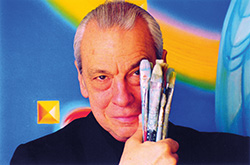 ”Let us perceive, at least for a moment, our life and our world with such optics and perspectives, and we will become strong, careless and light...” invited Ćirjanić. ”We must continue studying, and revealing to ourselves, our Serbian place in Europe. We would be surprised with new cognitions about our presence, from the Baltic to the Mediterranean, already in the pre-Christian period. We are building our European identity on new-old foundations. With the blood of our ancestors, we are embedded into the beginnings, into the foundations of the Hesiod myth about Hyperborea much more than we think. (...) See, that is the past and the future the man and the woman in Dragoš Kalajić’s paintings are gazing at...”
”Let us perceive, at least for a moment, our life and our world with such optics and perspectives, and we will become strong, careless and light...” invited Ćirjanić. ”We must continue studying, and revealing to ourselves, our Serbian place in Europe. We would be surprised with new cognitions about our presence, from the Baltic to the Mediterranean, already in the pre-Christian period. We are building our European identity on new-old foundations. With the blood of our ancestors, we are embedded into the beginnings, into the foundations of the Hesiod myth about Hyperborea much more than we think. (...) See, that is the past and the future the man and the woman in Dragoš Kalajić’s paintings are gazing at...”
In one of the forty-eight pre-pop-art TVs-windows, in the large mosaic painting Diary from 1964, we see very young Dragoš Kalajić watching the ”noisy emptiness”, the ”hubbub of the world”, with an ironic distance and obvious boredom. The painting Muzil from 1967 explores contemporary sinking to the level of ”human without features”, loss of the God-man image in the madness of anthropocentrism and massification. The painting Dragoš speaks to Mašić, Reljić and Šejka about the uniting of Europe (1968) – where we see symbols of the European Union and present fate of a European human – is a prophecy game characteristic for Kalajić. In the Hyperboreans from 1973, as well as in untitled paintings from 1976 and 1977, he is already a long way towards the ”land behind the north wind”. We break out to the peaks through Genetic Altruism (1979) and Nike (second half of the seventies). From there, one ”sees to the Beginning, to the End”. Such paintings are Knight of the Solar Order (1986-1987) and Wolfgang – from the Portraits of European nations cycle (1993).
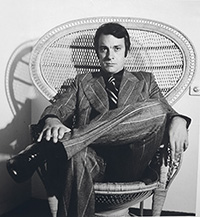 ”In the late sixties, he abandoned the avant-garde type of painting and turned to what he truly believed in, risking not to be modern and successful”, writes art critic Dejan Đorić, author of the exhibition, in the comprehensive essay Warrior of Light published in the catalogue. ”He considered his later paintings better than the old ones. Lonely in Serbian art, he made an incredible turn, equal to a spiritual feat. After works which did not request great artistic skills, he began painting completely different ones, large formats, requesting compositions, with different perspective, with figures implying the knowledge of anatomy, in daring colors. Experiments, which would take many into artistic nihilism, did not seduce him. He was expressed as a magnificent painter. (...) The golden top of mythical mountains, Indo-European and Arian symbolism of his oils, separated him from everything known in the Serbian and European art scene. Heraldic, emblematic presentations of monumental compositions, often proportions, similar to iconological tractates, were created in harmony with the coldness and discipline of his personal and above-personal requests: solidly and strictly, without a visible trace of brush, enjoying the matter and act of painting, rejecting sentimentality and traditional understanding of painting. He was interested in visionary futurism or archeofuturism, so he was in constant turn (and movement) from the past towards the future. (...) He did not consider Belgrade, like Šejka and Dragan Mojović, only as the center of the world, but also as the possible center of the future European renascence of painting, hoping that a completely new style would be formed in it.”
”In the late sixties, he abandoned the avant-garde type of painting and turned to what he truly believed in, risking not to be modern and successful”, writes art critic Dejan Đorić, author of the exhibition, in the comprehensive essay Warrior of Light published in the catalogue. ”He considered his later paintings better than the old ones. Lonely in Serbian art, he made an incredible turn, equal to a spiritual feat. After works which did not request great artistic skills, he began painting completely different ones, large formats, requesting compositions, with different perspective, with figures implying the knowledge of anatomy, in daring colors. Experiments, which would take many into artistic nihilism, did not seduce him. He was expressed as a magnificent painter. (...) The golden top of mythical mountains, Indo-European and Arian symbolism of his oils, separated him from everything known in the Serbian and European art scene. Heraldic, emblematic presentations of monumental compositions, often proportions, similar to iconological tractates, were created in harmony with the coldness and discipline of his personal and above-personal requests: solidly and strictly, without a visible trace of brush, enjoying the matter and act of painting, rejecting sentimentality and traditional understanding of painting. He was interested in visionary futurism or archeofuturism, so he was in constant turn (and movement) from the past towards the future. (...) He did not consider Belgrade, like Šejka and Dragan Mojović, only as the center of the world, but also as the possible center of the future European renascence of painting, hoping that a completely new style would be formed in it.”
PATH TO THE STARS
”Integral human and uranian painter Dragoš Kalajić, similar to those seeking God, philosophers and poets, aspired towards overcoming the horrible cosmic depth and establishing a relation with the eternal. The closer to a final catastrophe, a true artist paints more for eternity”, adds Đorić. ”His warrior, ruler and heroine, mysterious and beautiful ally (perhaps a dual or alter ego?), manage to dominate an endless abyss; painting is a magical act and the author is a demiurge, who overrules the immeasurable and unconscious. The figures in paintings are executors of certain rituals, activities that give them power. Their world is cinematographically framed, and they are shown at their physical and metaphysical climax... Kalajić’s creator of the universe and sorceress rule the world of symbols, animals, ideas and spiritual messages, they use them to overcome internal challenges. Human figures in Kalajić’s paintings can be reduced to pure expressions of energy or intelligence, as an esotericist said, they vibrate on a plain different than the earthly one, close perhaps to theone of angels. Behind the chaos, fluid and amorphous, light shines as fulfillment that gives meaning. Such a superior idea, whatever artistic form it is realized in, always has a bigger significance than the non-integral, partial forms of expression. Kalajić does not only support a certain strategy, a method of surpassing (post)modern non-integrity, he does not act only on the level of technos, but opens a permanent path, which has always existed, a path to the stars.”
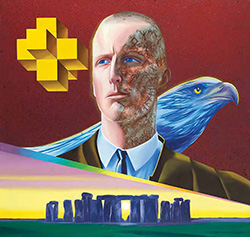 Kalajić’s exhibition provoked great interest of the public of different generations, especially the younger, educated ones searching for deeper grounding in their own identity. As time passes, the works of Dragoš Kalajić – painting, philosophy, literature, opinion journalism – are obviously gaining more significance and profoundness. Bogdan Desnica is right when he says that the website dedicated to Kalajić (www.dragoskalajic.com), special edition of the Nation magazine (www.e-nacija.com), ”Dragošdan” in Kinoteka, and this retrospective exhibition, are only a reminder and signpost. They are not and cannot be a replacement for a documentary-motion picture about Kalajić and scientific meeting about his creative work, for his collected works and representative art monograph, for an archive or legacy, for repeated broadcasting of his television achievements, for a street and monument. Serbian culture needs a new reading of Dragoš Kalajić, purified from everything marginal and accidental, and his permanent positioning in a place that indisputably belongs to him. (...) In Western Europe and Russia, much more often and more consistent than in Serbia, Kalajić is mentioned together with Evola and Malaparte, with Jünger and Dumézil, with Solzhenitsyn and Zinoviev, with De Chirico and Glazunov. They are not forgetting how many generations and layers of culture, how much effort and dreams, how much experience of the community and remembering of language it takes to have a personality of such knowledge and cognitions, such gifts and possibilities, such work, appear in a nation.”
Kalajić’s exhibition provoked great interest of the public of different generations, especially the younger, educated ones searching for deeper grounding in their own identity. As time passes, the works of Dragoš Kalajić – painting, philosophy, literature, opinion journalism – are obviously gaining more significance and profoundness. Bogdan Desnica is right when he says that the website dedicated to Kalajić (www.dragoskalajic.com), special edition of the Nation magazine (www.e-nacija.com), ”Dragošdan” in Kinoteka, and this retrospective exhibition, are only a reminder and signpost. They are not and cannot be a replacement for a documentary-motion picture about Kalajić and scientific meeting about his creative work, for his collected works and representative art monograph, for an archive or legacy, for repeated broadcasting of his television achievements, for a street and monument. Serbian culture needs a new reading of Dragoš Kalajić, purified from everything marginal and accidental, and his permanent positioning in a place that indisputably belongs to him. (...) In Western Europe and Russia, much more often and more consistent than in Serbia, Kalajić is mentioned together with Evola and Malaparte, with Jünger and Dumézil, with Solzhenitsyn and Zinoviev, with De Chirico and Glazunov. They are not forgetting how many generations and layers of culture, how much effort and dreams, how much experience of the community and remembering of language it takes to have a personality of such knowledge and cognitions, such gifts and possibilities, such work, appear in a nation.”
***
A Path to the Center
Dragoš Kalajić (February 22, 1943 – July 22, 2005, in Belgrade). Painter, writer, philosopher, opinion journalist. He graduated art at the Accademia di Belle Arti in Rome in 1965, with the highest grade (30 cum laude). He lived and worked in Belgrade and Rome. He was member of the Serbian Writers’ Association, Serbian Association of Fine Artists and Russian Writers’ Association. He worked as a free artist, journalist, publisher, gallery manager. His detailed bio-bibliography can be found at the official website www.dragoskalajic.com/put.
***
Exhibitions and Anthologies
During forty years of painting, Dragoš Kalajić had solo exhibitions in Belgrade (seven times), Rome (three times), Modena, Milan and Brescia (twice in each city), Brussels, Bologna, Zagreb, Sremski Karlovci, Valjevo. He participated at reputable festivals of contemporary art in Pittsburgh, Paris, Lion, Rome, Belgrade, Sarajevo... His creative work is enlisted in many anthologies of XX century art, including Udo Kultermann’s Neue formen, Enrico Crispolti’s L’avaguardie dell’doppoguerra in Europa and Miodrag B. Protić’s XX Century Painting and XX Century Serbian Painting.
***
Prince
”When he suddenly appeared in our environment, we were all surprised. A boy of extraordinary beauty, eloquence, sharpness of mind and big artistic talent stepped among us out of nowhere. We considered him, and still do, a kind of prince.” (Mihailo Đoković Tikalo, painter)
***
The Road of Silk and Sword
”Kalajić – the child of ‘Mediala’, friend of Leonid Šejka and Olja Ivanjicki, close to Ilija Savić, esotericist in the background of this group, and Slobodan Mašić, inseparable from Radomir Reljić and Miro Glavurtić for years, acquaintance of Ezra Pound, last person close to Baron Julius Evola, was an undisputable authority, arbiter elegantiarum... Warrior of light, compiler of the best Serbian edition about samurais, fighter and aesthetician on the road of silk and sword, similar to Yukio Mishima.” (Dejan Đorić)
***
A Face Shining in Memory
”Many of my friends have died or perished, so I feel, as Stevan Sremac nicely said, ‘like a bird whose flock has flown away...’ A face of a man appears in my insomnias, a man I knew a lot about before we met, the face of Dragoš Kalajić. (...) He can certainly be enlisted among the lighthouses of Serbian culture, who even bigger cultures and nations than ours would be proud of. He was one of the rare Serbian intellectuals, who had so much spiritual aristocratism, innate, in his thoughts, gestures, actions, that I truly admired it. He was the synthesis of an aesthetical and ethical human. (...) Dragoš Kalajić does not need my panegyric, and this writing can be understood only as a memory of one of his admirers and friends. His name will be shining in my memory and before my eyes, until both are extinguished.” (Radovan Karadžić)
***
Wounds of Christ
For the end, allow me one more memory. It is 1988. ”Studentski Grad” Cultural Home in Belgrade. Promotion of a new edition of About Heroes, the famous book written by Thomas Carlyle... Speaking about the book are also Irinej Bulović, PhD, today Bishop of Bačka, and Kalajić. When time came for questions from the audience, a young man stood up and asked Bulović: ”How come you, as a man of the Church and reputable theologian, sit calmly next to Dragoš Kalajić, who openly declares himself as a pagan?” The present Bishop of Bačka replied: ”You are still young and too hasty, you didn’t understand well. If you would look more carefully, with calmness in your heart, you would see what I see: the hands of Dragoš Kalajić are touching the wounds of Christ!” (Branislav Matić)
